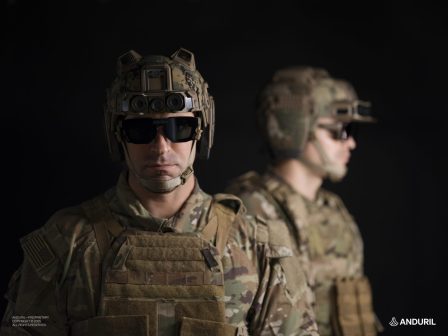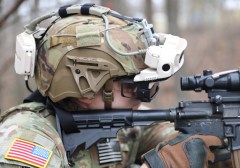Army awards more than $350M in contracts for Soldier Borne Mission Command system prototypes

The Army has awarded a total of more than $350 million in contracts to industry teams to rapidly prototype soldier-worn headsets equipped with augmented reality, night vision and AI capabilities, according to announcements from selected vendors.
Anduril announced Monday that it landed a $159 million deal for the Soldier Borne Mission Command (SBMC) program. A few days prior, Rivet announced that it executed a $195 million agreement for the project.
The initiative is “a new effort to develop a fused digital awareness system optimized to emerging modular sensor technologies while backwards compatible to the Android Tactical Assault Kit (ATAK) architecture. SBMC will be the Army’s future day/night situational awareness and mission command platform for Company level and below dismounted operations,” service officials wrote in a solicitation released in May.
The Army has suggested that its primary focus for SBMC, which was previously known as IVAS Next, is boosting troops’ operational capability on the battlefield. Enhancing training and readiness is expected to be an added bonus.
“It is a ‘fight first’ system with the benefit of rehearse and train capabilities,” officials wrote in a request for information released earlier this year.
An RFI inquired about vendors’ potential solutions with regard to heads-up display (HUD), body-worn compute, night vision capability, company-level communications network, and software supporting services or systems such as cloud or edge computing.
The Army also asked about how contractors’ technologies would enable the service’s human-machine integration concept and mitigate problems such as visual discomfort and nausea from virtual, mixed and AR headsets.
A previous Army effort known as the Integrated Visual Augmentation System (IVAS) program — for which Microsoft was initially the prime contractor — included heads-up displays with AR capabilities and sensors that were intended to enhance situational awareness for troops on the battlefield and in training. But that effort was beset with challenges — including soldier complaints about discomfort and nausea that resulted from wearing the headsets — and Anduril eventually took over as the prime contractor for that program earlier this year. The company had already incorporated its AI technology, based on its Lattice platform, into equipment for the IVAS program.
Anduril founder Palmer Luckey previously launched Oculus VR, a startup known for its commercial virtual reality headset which went on to be acquired by Facebook.
“I’m a big believer in augmented reality, virtual reality, mixed reality, whatever you want to call it. I’m a big believer in the virtuality continuum. And we’ve been building a lot of the underpinnings of SBMC for years at Anduril. It was one of the first things that we started working on using our own money. It’s taken eight years to finally get to the point where we’re building this stuff. We put hundreds of millions of our own dollars into building systems that will allow us to execute on this extremely fast and deliver something that is very, very mature and based on years and years of work that I was doing speculatively, hoping and praying that we would win this contract. And … it’s finally all playing out,” Luckey told reporters during a teleconference Monday.
“If I wouldn’t have been selected for SBMC I’d be having some really hard meetings with my investors, who had been insisting quite a while that this seemed to be the continuation of me having a pissing contest with Meta over who can build better head-mounted displays. They’re somewhat right, but it worked out in the end,” he added.
Years ago, after Oculus had been sold to Facebook — now known as Meta — for billions of dollars, Luckey was fired. However, relationships have been patched up and Anduril is now partnering with Meta as well as OSI on the Soldier Borne Mission Command program.
Luckey told DefenseScoop during Monday’s teleconference that the Anduril team’s technology will offer a variety of AR capabilities for soldiers.
Troops and commanders “want the ability to see where all of the bad guys that somebody has located are. They want to see where all the good guys are, they want to be doing augmented reality blue force tracking to make sure you’re not shooting at your own people. Always a really, really good thing to have. Doing navigation, waypoint display, showing where the safe zones are, where the unsafe zones are,” he said.
“You want to know where you can stand to not get blown up,” he continued. “There’s a lot … stuff like that, beyond also things like night vision. You want to be able to do stuff like control drones, control loitering munitions, just anything that before you would have been using a cell phone or a handheld controller or even a smart watch or even a dedicated laptop for, you want to be able to … use this device for. And then the last category is maybe the most interesting. There’s a lot of equipment that has displays, optics and interfaces that I can now replace almost entirely with my wearable display.”
DefenseScoop asked Luckey about how Anduril plans to mitigate some of the problems that soldiers complained about during the rollout of early versions of IVAS when that effort was led by Microsoft.
“I’m humble about some things. There’s others I’m not humble about. I am the world’s best head-mounted display designer. There’s nobody better than me, and I know what I’m doing, and I’m going to make sure that we do it the right way. And we’ve already proven that we’re making things that do not make people sick, they do not make them throw up,” he said. “If you’re going to make somebody wear something on their face, there’s a high level of friction and compromise. You need to make it very lightweight. You need to be brutal about the design of the thing, making it extremely comfortable, extremely light, and you need to make sure that it is only enhancing their experience of viewing the world, not degrading it. Otherwise, they’re just not going to wear it.”
Luckey pointed to Oculus’ previous successes at building virtual reality devices that didn’t make users sick as a reason for confidence in what Anduril will deliver for SBMC.
“If you have latency or mismatch between your inner ear and what your eye sees, there’s a mechanism for cyber sickness where your body believes it’s been poisoned, and it needs to expel the poison by vomiting. That’s why people get sick in these systems where you create mismatch in your inner ear and what your eye sees. I know how to make systems that don’t create that mismatch,” he said.
“I think it has been very well proven that the technology that I developed at Oculus can be used to make AR and VR headsets that do not make people sick, they do not degrade their vision. Even normal people with no training can put it on and for the very first time with no acclimation, use it, enjoy it, not get sick. So it’s a fair concern, but it is not one that I’m worried about, because we’ve already built hardware that fully, fully gets around that issue. Nobody is getting sick in [Anduril’s] EagleEye hardware, assuming you’re not putting them in a roller coaster application, or, you know, in a helicopter simulator where you’re spinning them around in circles,” he added.
Luckey said the first “scaled delivery” of the company’s SBMC system under the new contract is slated for 2027.
In a press release, Rivet described SBMC as a “next-generation capability for the U.S. Army that fuses data from Soldiers, sensors, and mission systems into one clear operational picture, day or night.”
The company “will help the Army field Soldier Borne Mission Command to the Infantry through rigorous iteration with Soldiers, ensuring an adaptable and extensible platform for lethality and overmatch against evolving threats,” the release added.
The vendor noted that it has assembled a “multidisciplinary team” for the effort, but the press release did not name other companies that it’s partnering with.
“We’re grateful for the Army’s confidence and are determined to deliver the most lethal capability to Soldiers at speed and budget,” Rivet CEO Dave Marra said in a statement.
Breaking Defense was first to report that Anduril and Rivet had been tapped for the program.





